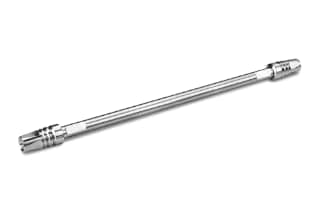
|
Chemistry |
Phenyl |
|
Separation Mode |
Reversed Phase |
|
Particle Substrate |
Hybrid |
|
pH Range Min |
1 pH |
|
pH Range Max |
12 pH |
|
Maximum Pressure |
18000 psi (1240 Bar) |
|
Endcapped |
Yes |
|
Bonding Technology |
Phenyl-Hexyl |
|
Silanol Activity |
Low |
|
Particle Shape |
Spherical |
|
Particle Size |
1.7 µm |
|
Endfitting Type |
Parker-style |
|
Pore Size |
130 Å |
|
Format |
Column |
|
Surface Area |
185 |
|
System |
UPLC, UHPLC |
|
Particle Technology |
BEH |
|
USP Classification |
L11 |
|
Inner Diameter |
2.1 mm |
|
Length |
150 mm |
|
Carbon Load |
15 % |
|
eCord |
Yes |
|
UNSPSC |
41115709 |
|
Brand |
ACQUITY UPLC |
|
Product Type |
Columns |
|
Units per Package |
1 pk |

ACQUITY UPLC BEH Phenyl-Hexyl Column, 130Å, 1.7 µm, 2.1 mm X 150 mm, 1/pk
ACQUITY UPLC BEH Phenyl-Hexyl Columns offer complementary selectivity to C18 stationary phases, especially when working with polyaromatic compounds. This sorbent combined with XBridge BEH Phenyl provides the most chemically stable phenyl sorbent currently on the market. This offers chromatographers benefits like ultra-low column bleed, long column lifetimes, and excellent peak shapes.
Because phenyl ligands contain stationary phases, they provide complementary selectivity to straight-chain alkyl phases, especially in molecules containing aromaticity due to pi-pi interactions. As a result of the trifunctionally bonded phenyl-hexyl ligand used in ACQUITY UPLC BEH Phenyl-Hexyl Columns, the lab equipment is able to provide industry-leading chemical stability, reproducibility, and peak shape across all analyte types. Combined with ACQUITY UPLC BEH Phenyl-Hexyl VanGuard Pre-column, 130Å, 1.7 µm, 2.1 mm X 5 mm, 3/pk, extended lifetimes can be achieved.
The inclusion of UPLC technology with BEH Phenyl columns has allowed for analysis of polymer additives to be achieved in only 3.5 minutes, up to 10 times faster than traditional HPLC methods. This helps to neutralize the effects of plastic-containing products worldwide and concerns around the safe use of plastic, reusability, and the demand for rapid and accurate analysis in plastics, food products, serum, and the environment.
All ACQUITY UPLC BEH column packing materials are designed specifically to be used with the ACQUITY UPLC system. As such, all parts are manufactured in a cGMP, ISO 9001 certified plant using ultra-pure reagents. Each batch of material is tested chromatographically using acidic, basic, and neutral analytes, with results held to narrow specification ranges to assure excellent and reproducible performance.
How Do I Determine Column Efficiency In ACQUITY UPLC BEH Phenyl-Hexyl Columns?
Upon receiving your columns, you should perform an initial test of column efficiency. This test can consist of multiple elements. An analyte test mixture that is commonly used in your laboratory will usually suffice. You can also use an analyte mixture that is found on the included Performance Test Chromatogram. Once this step is done, you can determine the number of theoretical plates (N) and use this value for periodic comparisons. Repeat this testing at predetermined intervals in order to track column performance over time. You may notice slight variations on different UPLC systems due to the quality of the connections, environmental factors, reagent quality, and operator technique.